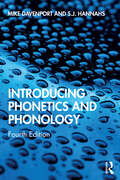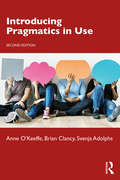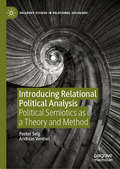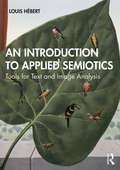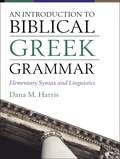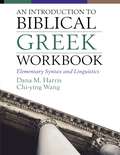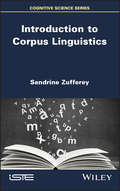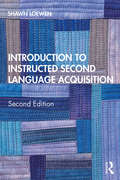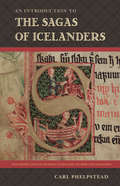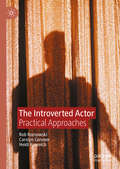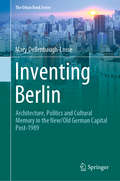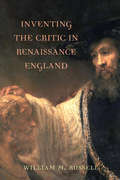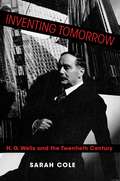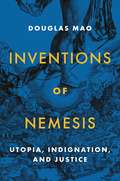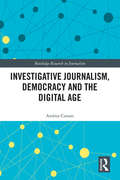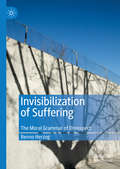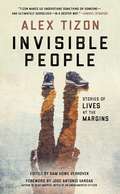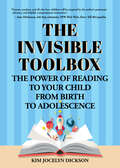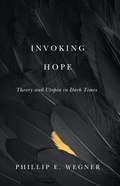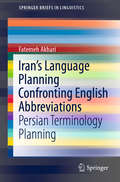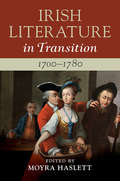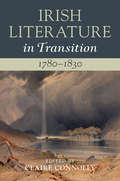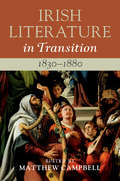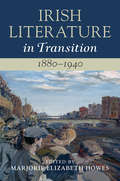- Table View
- List View
Introducing Phonetics and Phonology
by Mike Davenport S.J. HannahsIntended for the absolute beginner, Introducing Phonetics and Phonology requires no previous background in linguistics, phonetics or phonology. Starting with a grounding in phonetics and phonological theory, the book provides a base from which more advanced treatments may be approached. It begins with an examination of the foundations of articulatory and acoustic phonetics, moves on to the basic principles of phonology and ends with an outline of some further issues within contemporary phonology. Varieties of English, particularly Received Pronunciation and General American, form the focus of consideration, but aspects of the phonetics and phonology of other languages are discussed as well. This new edition includes revised exercises and examples; additional coverage of typology, autosegmental phonology and articulatory and acoustic phonetics; broader coverage of varieties that now features Australian English; and an extended Chapter 7 that includes more information on the relationship between phonetics and phonology. Introducing Phonetics and Phonology, 4th Edition remains the essential introduction for any students studying this topic for the first time.
Introducing Phonetics and Phonology
by Mike Davenport S.J. HannahsIntended for the absolute beginner, Introducing Phonetics and Phonology requires no previous background in linguistics, phonetics or phonology. Starting with a grounding in phonetics and phonological theory, the book provides a base from which more advanced treatments may be approached. It begins with an examination of the foundations of articulatory and acoustic phonetics, moves on to the basic principles of phonology and ends with an outline of some further issues within contemporary phonology. Varieties of English, particularly Received Pronunciation and General American, form the focus of consideration, but aspects of the phonetics and phonology of other languages are discussed as well. This new edition includes revised exercises and examples; additional coverage of typology, autosegmental phonology and articulatory and acoustic phonetics; broader coverage of varieties that now features Australian English; and an extended Chapter 7 that includes more information on the relationship between phonetics and phonology.Introducing Phonetics and Phonology, 4th Edition remains the essential introduction for any students studying this topic for the first time.
Introducing Pragmatics in Use
by Anne O'Keeffe Brian Clancy Svenja AdolphsIntroducing Pragmatics in Use is a lively and accessible introduction to pragmatics which both covers theory and applies it to real spoken and written data. This textbook systematically draws on a number of different language corpora and the corresponding software applications. Its primary focus is the application of a corpus methodology in order to examine core component areas such as deixis, politeness, speech acts, language variation and register. The main goal of the book is to contextualise pragmatics in the study of language through the analysis of different language contexts provided by spoken and written corpora. Substantially revised and updated, this second edition covers a wider range of topics, corpora and software packages. It consistently demonstrates the benefits of innovative analytical synergies and extends this to how corpus pragmatics can be further blended with, for example, conversation analysis or variational pragmatics. The second edition also offers a new chapter specifically dedicated to corpus pragmatics which proposes a framework for both form-to-function and function-to-form approaches. The book also addresses the – sometimes thorny – area of the integration of the teaching of pragmatics into the language classroom. All chapters in the second edition include a number of cohesive, step-by-step tasks that can be done in small groups in class or can be used as self-study resources. A wide range of illustrative language samples drawn from a number of English language corpora, coupled with instructive tasks and annotated further reading sections, make this an ideal textbook for advanced undergraduate or postgraduate students of pragmatics, discourse analysis and corpus linguistics within applied languages / linguistics or TESOL programmes.
Introducing Relational Political Analysis: Political Semiotics as a Theory and Method (Palgrave Studies in Relational Sociology)
by Peeter Selg Andreas VentselThis book introduces relational thinking to political analysis. Instead of merely providing an overview of possible trajectories for articulating a relational political analysis, Peeter Selg and Andreas Ventsel put forth a concrete relational theory of the political, which has implications for research methodology, culminating in a concrete method they call political form analysis. In addition, they sketch out several applications of this theory, methodology and method. They call their approach “political semiotics” and argue that it is a fruitful way of conducting research on power, governance and democracy – the core dimensions of the political – in a manner that is envisioned in numerous discussions of the “relational turn” in the social sciences. It is the first monograph that attempts to outline an approach to the political that would be relational throughout, from its meta theoretical and theoretical premises through to its methodological implications, methods and empirical applications.
An Introduction to Applied Semiotics: Tools for Text and Image Analysis
by Louis HébertAn Introduction to Applied Semiotics presents nineteen semiotics tools for text and image analysis. Covering a variety of different schools and approaches, together with the author’s own original approach, this is a full and synthetic introduction to semiotics. This book presents general tools that can be used with any semiotic product. Drawing on the work of Fontanille, Genette, Greimas, Hébert, Jakobson, Peirce, Rastier and Zilberberg, the tools deal with the analysis of themes and action, true and false, positive and negative, rhythm narration and other elements. The application of each tool is illustrated with analyses of a wide range of texts and images, from well-known or distinctive literary texts, philosophical or religious texts or images, paintings, advertising and everyday signs and symbols. Each chapter has the same structure – summary, theory and application – and includes exercises and discussion questions, making it ideal for course use. Covering both visual and textual objects, this is a key text for all courses in semiotics and textual analysis within linguistics, communication studies, literary theory, design, marketing and related areas.
An Introduction to Biblical Greek Grammar: Elementary Syntax and Linguistics
by Dana M. HarrisAn Introduction to Biblical Greek Grammar focuses on the linguistic and syntactic elements of Koine Greek to equip learners for accurate interpretation. Drawing upon twenty years of Greek teaching experience and the latest developments in linguistics and syntax, Harris introduces students to basic linguistic concepts and categories necessary for grasping Greek in ways that are clear and intuitive. This solid foundation enables students first to internalize key concepts, then to apply and build upon them as more complex ideas are introduced.Several features are specifically designed to aid student's learning:Key concepts are graphically coded to offer visual reinforcement of explanations and to facilitate learning forms and identifying their functionsKey concepts are followed by numerous examples from the Greek New TestamentStudents learn how to mark Greek texts so that they can begin to "see" the syntax, identify the boundaries of syntactic units, and construct syntactic outlines as part of their preaching or teaching preparationFour integrative chapters, roughly corresponding to the midterms and final exams of a two-semester sequence, summarize material to date and reinforce key concepts. Here students are also introduced to exegetical and interpretive concepts and practices that they will need for subsequent Greek studies and beyond."Going Deeper" and "For the Curious" offer supplemental information for students interested in learning more or in moving to advanced language study.The accompanying workbook and video lectures (both sold separately) reinforce key concepts through additional contact with the material from each chapter of the grammar. All exercises in the workbook are taken from the Greek New Testament and the Septuagint and include extensive syntactical and exegetical notes to aid students.
An Introduction to Biblical Greek Workbook: Elementary Syntax and Linguistics
by Dana M. Harris Chi-ying WongThis workbook is designed to accompany An Introduction to Biblical Greek Grammar, which focuses on the linguistic and syntactic elements of Koine Greek to equip learners for accurate interpretation. It reinforces key concepts student learn through parsing and translation exercises for each chapter. All texts are taken from the Greek New Testament and the Septuagint and include extensive syntactical and exegetical notes to aid students.In An Introduction to Biblical Greek Grammar, author Dana Harris draws upon twenty years of Greek teaching experience and the latest developments in linguistics and syntax to introduce students to basic linguistic concepts and categories necessary for grasping Greek in ways that are clear and intuitive. This solid foundation enables students first to internalize key concepts, then to apply and build upon them as more complex ideas are introduced.Several features are specifically designed to aid student's learning:Key concepts are graphically coded to offer visual reinforcement of explanations and to facilitate learning forms and identifying their functionsKey concepts are followed by numerous examples from the Greek New TestamentStudents learn how to mark Greek texts so that they can begin to "see" the syntax, identify the boundaries of syntactic units, and construct syntactic outlines as part of their preaching or teaching preparationFour integrative chapters, roughly corresponding to the midterms and final exams of a two-semester sequence, summarize material to date and reinforce key concepts. Here students are also introduced to exegetical and interpretive concepts and practices that they will need for subsequent Greek studies and beyond."Going Deeper" and "For the Curious" offer supplemental information for students interested in learning more or in moving to advanced language study.
Introduction to Corpus Linguistics
by Sandrine ZuffereyOver the past decades, the use of quantitative methods has become almost generalized in all domains of linguistics. However, using these methods requires a thorough understanding of the principles underlying them. Introduction to quantitative methods in linguistics aims at providing students with an up-to-date and accessible guide to both corpus linguistics and experimental linguistics. The objectives are to help students developing critical thinking about the way these methods are used in the literature and helping them to devise their own research projects using quantitative data analysis.
Introduction to Instructed Second Language Acquisition
by Shawn LoewenNow in its second edition, Introduction to Instructed Second Language Acquisition continues to present a cohesive view of the different theoretical and pedagogical perspectives that comprise instructed second language acquisition (ISLA). Loewen provides comprehensive discussions of the theoretical, empirical, and pedagogical aspects of a range of key issues in ISLA, and has added to this edition a comprehensive exploration of the relationship between ISLA research and second language pedagogy. Also new is the addition of supporting features including end-of-chapter activities, points for reflection, and discussion questions, as well as thoroughly revised content to reflect the most recent research in ISLA. This is an essential resource for students new to ISLA, or working in Second Language Acquisition more generally.
An Introduction to the Sagas of Icelanders (New Perspectives on Medieval Literature: Authors and Traditions)
by Carl PhelpsteadCombining an accessible approach with innovative scholarship, An Introduction to the Sagas of Icelanders provides up-to-date perspectives on a unique medieval literary genre that has fascinated the English-speaking world for more than two centuries. Carl Phelpstead draws on historical context, contemporary theory, and close reading to deepen our understanding of Icelandic saga narratives about the island’s early history. Phelpstead explores the origins and cultural setting of the genre, demonstrating the rich variety of oral and written source traditions that writers drew on to produce the sagas. He provides fresh, theoretically informed discussions of major themes such as national identity, gender and sexuality, and nature and the supernatural, relating the Old Norse-Icelandic texts to questions addressed by postcolonial studies, feminist and queer theory, and ecocriticism. He then presents readings of select individual sagas, pointing out how the genre’s various source traditions and thematic concerns interact. Including an overview of the history of English translations that shows how they have been stimulated and shaped by ideas about identity, and featuring a glossary of critical terms, this book is an essential resource for students of the literary form. A volume in the series New Perspectives on Medieval Literature: Authors and Traditions, edited by R. Barton Palmer and Tison Pugh
The Introverted Actor: Practical Approaches
by Rob Roznowski Carolyn Conover Heidi KasevichDo you have to be an extrovert to succeed as an actor? This book offers ideas to create inclusive acting environments where the strengths of the introverted actor are as valued as those of their extroverted counterparts. As this book shows, many introverts are innately drawn to the field of acting, but can often feel inferior to their extroverted peers. From the classroom to professional auditions, from rehearsals to networking events, introverted actors tell their stories to help other actors better understand how to leverage their natural gifts, both onstage and off. In addition, The Introverted Actor helps to reimagine professional and pedagogical approaches for both actor educators and directors by offering actionable advice from seasoned psychology experts, professional actors, and award-winning educators.
Inventing Berlin: Architecture, Politics and Cultural Memory in the New/Old German Capital Post-1989 (The Urban Book Series)
by Mary Dellenbaugh-LosseThis book comprehensively examines post-1989 changes to the symbolic landscape of Berlin – specifically, street names, architecture, urban planning and monuments – and links these changes to concepts of contested cultural memory and national identity in Berlin and Germany in the post-Wall period. The core of the book is made up of an analysis of built space changes in the eastern half of the city before and after the Berlin Wall, flanked by an introduction to the theoretical underpinnings of the topic and a wider interpretation of the events in Berlin in relation to other geographic and historical contexts. It furthermore offers an explanatory model for the phenomenon of the "symbolic foreigner" whereby former citizens of the GDR feel disenfranchised and excluded from today's German society. This book is a valuable resource for researchers, students, and also appeals to a wider, non-academic audience with an interest in both cultural memory and Berlin.
Inventing the Critic in Renaissance England
by William M. RussellThe turn of the seventeenth century was an important moment in the history of English criticism. In a series of pioneering works of rhetoric and poetics, writers such as Philip Sidney, George Puttenham, and Ben Jonson laid the foundations of critical discourse in English, and the English word "critic" began, for the first time, to suggest expertise in literary judgment. Yet the conspicuously ambivalent attitude of these critics toward criticism—and the persistent fear that they would be misunderstood, marginalized, scapegoated, or otherwise "branded with the dignity of a critic"—suggests that the position of the critic in this period was uncertain. In Inventing the Critic in Renaissance England, William Russell reveals that the critics of the English Renaissance did not passively absorb their practice from Continental and classical sources but actively invented it in response to a confluence of social and intellectual factors.Distributed for UNIVERSITY OF DELAWARE PRESS
Inventing Tomorrow: H. G. Wells and the Twentieth Century
by Sarah ColeH. G. Wells played a central role in defining the intellectual, political, and literary character of the twentieth century. A prolific literary innovator, he coined such concepts as “time machine,” “war of the worlds,” and “atomic bomb,” exerting vast influence on popular ideas of time and futurity, progress and decline, and humanity’s place in the universe. Wells was a public intellectual with a worldwide readership. He met with world leaders, including Roosevelt, Lenin, Stalin, and Churchill, and his books were international best-sellers. Yet critics and scholars have largely forgotten his accomplishments or relegated them to genre fiction, overlooking their breadth and diversity.In Inventing Tomorrow, Sarah Cole provides a definitive account of Wells’s work and ideas. She contends that Wells casts new light on modernism and its values: on topics from warfare to science to time, his work resonates both thematically and aesthetically with some of the most ambitious modernists. At the same time, unlike many modernists, Wells believed that literature had a pressing place in public life, and his works reached a wide range of readers. While recognizing Wells’s limitations, Cole offers a new account of his distinctive style as well as his interventions into social and political thought. She illuminates how Wells embodies twentieth-century literature at its most expansive and engaged. An ambitious rethinking of Wells as both writer and thinker, Inventing Tomorrow suggests that he offers a timely model for literature’s moral responsibility to imagine a better global future.
Inventions of Nemesis: Utopia, Indignation, and Justice
by Douglas MaoA wide-ranging reevaluation of utopian literature and philosophy, from Plato to Chang-Rae LeeExamining literary and philosophical writing about ideal societies from Greek antiquity to the present, Inventions of Nemesis offers a striking new take on utopia’s fundamental project.Noting that utopian imagining has often been propelled by an angry conviction that society is badly arranged, Douglas Mao argues that utopia’s essential aim has not been to secure happiness, order, or material goods, but rather to establish a condition of justice in which all have what they ought to have. He also makes the case that hostility to utopias has frequently been associated with a fear that they will transform humanity beyond recognition, doing away with the very subjects who should receive justice in a transformed world. Further, he shows how utopian writing speaks to contemporary debates about immigration, labor, and other global justice issues. Along the way, Inventions of Nemesis connects utopia to the Greek concept of nemesis, or indignation at a wrong ordering of things, and advances fresh readings of dozens of writers and thinkers—from Plato, Thomas More, Nathaniel Hawthorne, Edward Bellamy, Charlotte Perkins Gilman, and H. G. Wells to John Rawls, Robert Nozick, Fredric Jameson, Ursula Le Guin, Octavia Butler, and Chang-Rae Lee.Ambitious and timely, Inventions of Nemesis offers a vital reconsideration of what it really means to imagine an ideal society.
Investigative Journalism, Democracy and the Digital Age (Routledge Research in Journalism)
by Andrea CarsonTheoretically grounded and using quantitative data spanning more than 50 years together with qualitative research, this book examines investigative journalism’s role in liberal democracies in the past and in the digital age. In its ideal form, investigative reporting provides a check on power in society and therefore can strengthen democratic accountability. The capacity is important to address now because the political and economic environment for journalism has changed substantially in recent decades. In particular, the commercialization of the Internet has disrupted the business model of traditional media outlets and the ways news content is gathered and disseminated. Despite these disruptions, this book’s central aim is to demonstrate using empirical research that investigative journalism is not in fact in decline in developed economies, as is often feared.
Invisibilization of Suffering: The Moral Grammar of Disrespect
by Benno HerzogThis book offers a comprehensive theory of invisibility as a critical sociological concept, addressing the relationship between social suffering and invisibilization. Herzog draws on social theory and a variety of empirical examples to analyze social grammar and unveil various mechanisms of social suffering. Presenting an original theory of silencing and suffering, this book outlines a substantive theory and methodology of invisibilization as an instrument of authority. This systemic analysis of visibility as both a liberating and dominating mechanism will be a major contribution to the field of critical theory, offering an original framework to help improve the situation of excluded groups and individuals.Invisibilization of Suffering will be an invaluable resource for students and scholars across sociology, social philosophy, social work, political sciences, criminology, linguistics and education, with a focus on justice theory, marginalization, discrimination and exclusion.
Invisible People: Stories of Lives at the Margins
by Alex Tizon Sam Howe Verhovek“Somewhere in the tangle of the subject’s burden and the subject’s desire is your story.”—Alex Tizon Every human being has an epic story. The late Pulitzer Prize–winning writer Alex Tizon told the epic stories of marginalized people—from lonely immigrants struggling to forge a new American identity to a high school custodian who penned a New Yorker short story. Edited by Tizon’s friend and former colleague Sam Howe Verhovek, Invisible People collects the best of Tizon’s rich, empathetic accounts—including “My Family’s Slave,” the Atlantic magazine cover story about the woman who raised him and his siblings under conditions that amounted to indentured servitude. Mining his Filipino American background, Tizon tells the stories of immigrants from Cambodia and Laos. He gives a fascinating account of the Beltway sniper and insightful profiles of Surfers for Jesus and a man who tracks UFOs. His articles—many originally published in the Seattle Times and the Los Angeles Times—are brimming with enlightening details about people who existed outside the mainstream’s field of vision. In their introductions to Tizon’s pieces, New York Times executive editor Dean Baquet, Atlantic magazine editor in chief Jeffrey Goldberg, Pulitzer Prize winners Kim Murphy and Jacqui Banaszynski, and others salute Tizon’s respect for his subjects and the beauty and brilliance of his writing. Invisible People is a loving tribute to a journalist whose search for his own identity prompted him to chronicle the lives of others.
The Invisible Toolbox: The Power of Reading to Your Child from Birth to Adolescence
by Kim Jocelyn DicksonAn Essential Tool for Preparing Your Child for Kindergarten and BeyondReading aloud to your children is essential. Longtime elementary school teacher Kim Jocelyn Dickson believes every child begins kindergarten with a lunchbox in one hand and an “invisible toolbox” in the other. In The Invisible Toolbox, Kim shares with parents the single most important thing they can do to foster their child’s future learning potential and nurture the parent-child bond that is the foundation for a child’s motivation to learn. She is convinced that the simple act of reading aloud has a far-reaching impact that few of us fully understand and that our recent, nearly universal saturation in technology has further clouded its importance.In The Invisible Toolbox, parents, educators, and early literacy advocates will discover:Ten priceless tools that will fill their child’s toolbox when they read aloud to their childTools parents can give themselves to foster these gifts in their childrenPractical tips for how and what to read aloud to children through their developmental stagesDos and don’ts and recommended resources that round out all the practical tools a parent will need to prepare their child for kindergarten and beyondEssential book for parents. In The Invisible Toolbox, Kim weaves her practical anecdotal experience as an educator and parent into the hard research of recent findings in neuroscience. She reminds us that the first years of life are critical in the formation and receptivity of the primary predictor of success in school—language skills—and that infants begin learning immediately at birth. She also teaches and inspires us to build our own toolboxes so that we can help our children build theirs.If you enjoyed books like Honey for a Child's Heart, The Read-Aloud Handbook, Screenwise, or The Enchanted Hour; you will love The Invisible Toolbox—from a 21st century Charlotte Mason.
Invoking Hope: Theory and Utopia in Dark Times
by Phillip E. WegnerAn appeal for the importance of theory, utopia, and close consideration of our contemporary dark times What does any particular theory allow us to do? What is the value of doing so? And who benefits? In Invoking Hope, Phillip E. Wegner argues for the undiminished importance of the practices of theory, utopia, and a deep and critical reading of our current situation of what Bertolt Brecht refers to as finsteren Zeiten, or dark times.Invoking Hope was written in response to three events that occurred in 2016: the five hundredth anniversary of the publication of Thomas More&’s Utopia; the one hundredth anniversary of the founding text in theory, Ferdinand de Saussure&’s Course in General Linguistics; and the rise of the right-wing populism that culminated in the election of Donald Trump. Wegner offers original readings of major interventions in theory alongside dazzling utopian imaginaries developed from classical Greece to our global present—from Theodor Adorno, Ernst Bloch, Alain Badiou, Jacques Derrida, Fredric Jameson, Sarah Ahmed, Susan Buck-Morss, and Jacques Lacan to such works as Plato&’s Republic, W. E. B. Du Bois&’s John Brown, Isak Dinesen&’s &“Babette&’s Feast,&” Kim Stanley Robinson&’s 2312, and more. Wegner comments on an expansive array of modernist and contemporary literature, film, theory, and popular culture.With Invoking Hope, Wegner provides an innovative lens for considering the rise of right-wing populism and the current crisis in democracy. He discusses challenges in the humanities and higher education and develops strategies of creative critical reading and hope against the grain of current trends in scholarship.
Iran’s Language Planning Confronting English Abbreviations: Persian Terminology Planning (SpringerBriefs in Linguistics)
by Fatemeh AkbariThis book addresses one of the most crucial and common questions confronting planners of languages other than English, that is, how the impacts of global languages on local languages should be dealt with: internationalization or local language promotion? This empirical study examines the implementation of Iran’s governmental language and terminology policy to accelerate rarely used abbreviation methods in Persian in order to preserve the language from the extensiveness of borrowed English abbreviated forms. This book provides an in-depth analysis of relevant linguistic theories as well as the structure and social context of the Persian language itself, rather than relying on personal opinions or beliefs either in favour of or against abbreviation. The text appeals to politicians, language planners, terminologists, lecturers, authors and translators of scientific works, especially those who are speakers of languages other than English and seek to promote their local languages. This book is particularly relevant to linguistics students (both undergraduate and graduate students) and language teachers and researchers in the broader areas of language education and curriculum design.
Irish Literature in Transition, 1700–1780: Volume 1 (Irish Literature in Transition)
by Moyra HaslettThis volume examines eighteenth-century Irish literature, highlighting the diversity of texts, authors and approaches that characterises contemporary studies of the period. Chapters consider the contexts of history, politics, language, philosophy, gender, sexuality, and the environment while situating Irish literature in relation to Ireland, Britain, Europe and beyond. Well-known authors (Jonathan Swift, Edmund Burke and Oliver Goldsmith) are read alongside less familiar writers (including Mary Barber, William Chaigneau, Frances Sheridan, and Samuel Whyte) and popular and ephemeral literatures take their place with formerly canonical texts. It demonstrates the exciting vitality and richness of eighteenth-century Irish literature - written and performed - as well as its complex intersections with different communities and traditions. This book will be a key resource to scholars and students of Irish eighteenth-century studies as well as readers generally interested in questions of Anglophone and Irish-language culture, representations of gender and sexuality, and national and trans-national identities.
Irish Literature in Transition, 1780–1830: Volume 2 (Irish Literature in Transition)
by Claire ConnollyThe years between 1780 and 1830 are vital decades in the history of Irish writing in English. This book charts the confluence of Enlightenment, antiquarian, and romantic energies within Irish literary culture and shows how different writers and genres absorbed, dispersed and remade those interests during five decades of political change. During those same years, literature made its own history. By the 1840s, Irish writing formed a recognizable body of work, which later generations would draw on, quote, anthologize and dispute. Questions raised by novels, poems and plays of the late eighteenth and early nineteenth centuries - the politics of language and voice; the relationship between literature and locality; the possibility of literature as a profession - resonated for many Irish writers over the centuries that followed and continue to matter today. This comprehensive volume will be a key reference for scholars and students of Irish literature and romantic literary studies.
Irish Literature in Transition, 1830–1880: Volume 3 (Irish Literature in Transition)
by Matthew CampbellIreland's experience in the nineteenth century was quite different from that of Victorian Britain. Its fictions were written in differing forms – like the gothic or historical novel – and its poetry and drama were populated with ballad and song. Its writers were by turns nationalist or unionist, anglophile or de-anglicising. If the effects of Famine and emigration were catastrophic for mid-nineteenth-century Irish culture, they initiated a literary story that spread across the diaspora. Despite the decline of spoken Irish, literature continued to be published, while scholarly endeavours such as translation or the Ordnance Survey preserved much from the Gaelic past. This rich volume examines the many forms of new writing that thrived throughout this period. Utilizing a thematic and historical approach, it addresses a broad anglophone readership in Victorian literature. Essays consider the Irish authors in America and India, women's writing, and the resilience of Irish literature before the revival.
Irish Literature in Transition, 1880–1940: Volume 4 (Irish Literature in Transition)
by Marjorie HowesThe years between 1880 and 1940 were a time of unprecedented literary production and political upheaval in Ireland. It is the era of the 1916 Easter Rising, the Irish Revival, and a time when many major Irish writers - Yeats, Joyce, Beckett, Lady Gregory - profoundly impacted Irish and World Literature. Recent research has uncovered new archives of previously neglected texts and authors. Organized according to multiple categories, ranging from single author to genre and theme, this volume allows readers to imagine multiple ways of re-mapping this crucial period. The book incorporates different, even competing, approaches and interpretations to reflect emerging trends and current debates in contemporary scholarship. As ongoing research in the field of Irish studies discovers new materials and critical strategies for interpreting them, our sense of Irish literary history during this period is constantly shifting. This volume seeks to capture the richness and complexity of the years 1880-1940 for our current moment.
